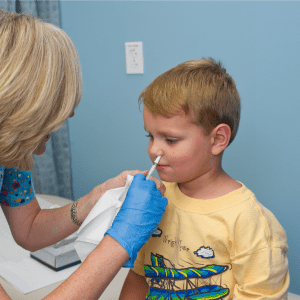Exclusive Public health officials have branded the scheme to vaccinate two- and three-year olds against flu this winter a success, although GP leaders have warned that practices need more support to ensure that parents understand the benefits of the immunisation programme.
The public health body said the 40% uptake in healthy two- and three-year-olds achieved by practices this flu season was ‘very encouraging’ and meant the approach would prove cost-effective.
PHE said they would be evaluating the scheme in GP practices – and the results of schools-based pilots in older children – later this month to determine how they would be rolling out the scheme to more children from September.
But GP leaders told Pulse success of the scheme was down to hard-working practices doing their utmost to vaccinate as many children as possible before vaccine stocks expired, and that they needed more help to inform parents about the importance of immunising healthy children against flu.
GPs were urged to ensure they vaccinated as many of their target two- and three-year-olds before the Christmas holidays, particularly because the vast majority of centrally ordered stocks of the nasal flu vaccine expired last month.
Latest uptake figures show – as of 30 January – 42.6% of two- and 39.3% of three-year-olds – both at-risk and not – have been vaccinated.
A spokesperson for PHE said that this was well above the 30% threshold that would make the programme cost-effective.
He said: ‘Extending the programme to low-risk children is cost effective as it lowers the impact of influenza on children and also lowers influenza transmission from children to other children, adults and those in the clinical risk groups of any age. The models suggest that even with modest coverage (around 30%) the childhood programme is cost effective.
‘The level of uptake (42.6% in all two-year-olds and 39.3% in all three-year-olds) in the first year is therefore very encouraging given the considerable structural change that the health system has undergone and when compared with other vaccination introductions.’
Dr David Elliman, lead on immunisation at the Royal College of Paediatrics and Child Health, agreed the uptake was ‘reasonably good’ given there is relatively low awareness among parents of the need for flu vaccinations.
But he added that GPs could be needed to extend the programme to four-year-olds this year because of the difficulty capturing this age group through schools.
He said: ‘At a guess, because a lot of four-year-olds will not be in schools yet or may be in school only in very small numbers it won’t be cost-effective for school nurses to do them, so it may be those may be done in general practice alongside the two- and three-year-olds.’
He added: ‘Even if it is introduced in schools, you would need to have to have some “mop up” in the community – either school nurses doing clinics outside of school or general practices.’
But leading GPs warned Public Health England and area teams needed to do more to help practices with the campaign.
Dr George Kassianos, RCGP lead on immunisation and a GP in Bracknell, Berkshire, said: ‘In my practice, we sent parents of all two- and three-year olds two letters and text messages, we vaccinated in clinics, opportunistically, opened on four Saturdays, advertised in the practice premises and the website and still, we did not manage to immunise these children in sufficient numbers.
‘We just managed to vaccinate 53.5% of the two-year olds and only 39.7% of the three-year olds. We needed to do better and the only way we could have done would have been a sustained media campaign to reach all parents in the country. In this case, we needed to reach and educate the parents.’
Dr Jim Kennedy, medical secretary at Berkshire, Buckinghamshire and Oxfordshire LMC and a GP in Wargrave, near Reading, agreed practices needed more support to deliver the campaign.
Dr Kennedy said: ‘With any group as young as this, it takes a few years for the message really to get through [to parents], but both nationally and locally a lot more could be done by NHS organisations – certainly they could be doing more to get messages out through nurseries and mother-toddler groups and so on.’

















